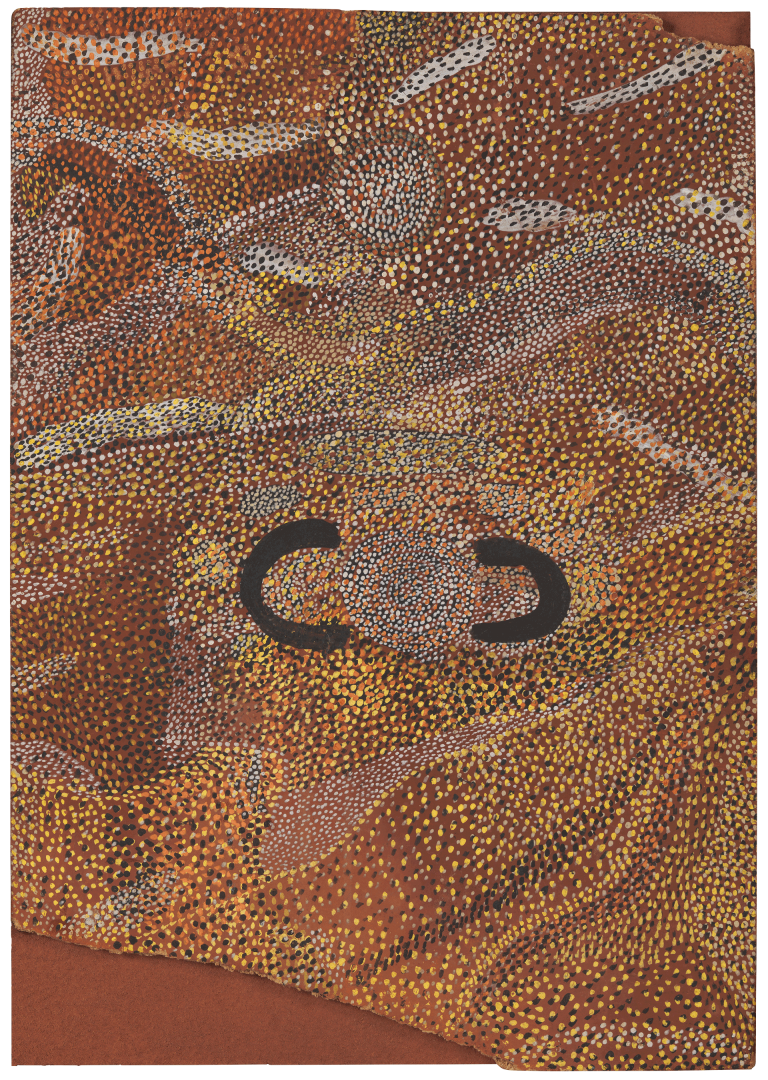We acknowledge the Traditional Owners of the land on which the Queensland Art Gallery | Gallery of Modern Art stands and recognise the creative contribution First Australians make to the art and culture of this country.

Johnny Warrangkula Tjupurrula / Luritja people / Australia 1920–2001 / Old man’s bush tucker Dreaming 1972 | Synthetic polymer paint on composition board | 50 x 45cm (irreg.) / Purchased 1994. Queensland Art Gallery Foundation / Collection: Queensland Art Gallery / © Estate of the artist/Licensed by Aboriginal Artists Agency Ltd
Johnny Warrangkula TjupurrulaOld man’s bush tucker Dreaming 1972
On Display: QAG, Gallery 13
Old man’s bush tucker Dreaming 1972 shows two men sitting opposite each other at a camp fire eating bush raisins. Concentric circles at the top of the painting mark out a waterhole, and other areas of dotting represent grass, food plants and sand.
Stories about the relationship between food, people and the landscape impart practical knowledge about food sources and managing resources to avoid depleting food. The distinction between spiritual and secular teaching does not exist in tribal Aboriginal art the way it does in the European tradition — correct use of the land has a religious dimension in Western Desert painting. In many artworks, the secret–sacred subject matter requires that specific references be veiled by painting in dots rather than describing forms and symbols more literally.
Of all the Papunya artists, Johnny Warrangkula Tjupurrula is generally regarded as having achieved the most subtle and complex layering of these dots in his paintings. Old man’s bush tucker Dreaming is a particularly successful example of these mingling veils of colour for which his work is admired.
Johnny Warrangkula Tjupurrula was born in Mintjilpirri in the south-western corner of the Northern Territory. He grew up in the desert without exposure to Western schooling and moved to the Hermannsburg mission with his family as a young man where he worked as a labourer on the airstrip. He was a village councillor at Papunya, and one of the first group of elders who became the ‘painting men’ at Papunya in 1971.
Warrangkula Tjupurrula had a slight tremor and some difficulty using brushes, so he came to favour a dotting and over-dotting technique with which he achieved great expressiveness. Geoffrey Bardon, the influential art teacher at the Papunya School, described him as ‘one of the great Papunya masters’.1
Note: The artist’s language group is sometimes described as ‘Warlpiri/Luritja’. There is no Luritja language as such; it is an Arrernte word meaning ‘from somewhere else’. It is used by Western Desert Aborigines to describe a Creole, or hybrid version of a traditional language.
Endnotes:
1 Geoffrey Bardon, Papunya Tula: Art of the Western Desert, Penguin, Melbourne, 1991, p.39.